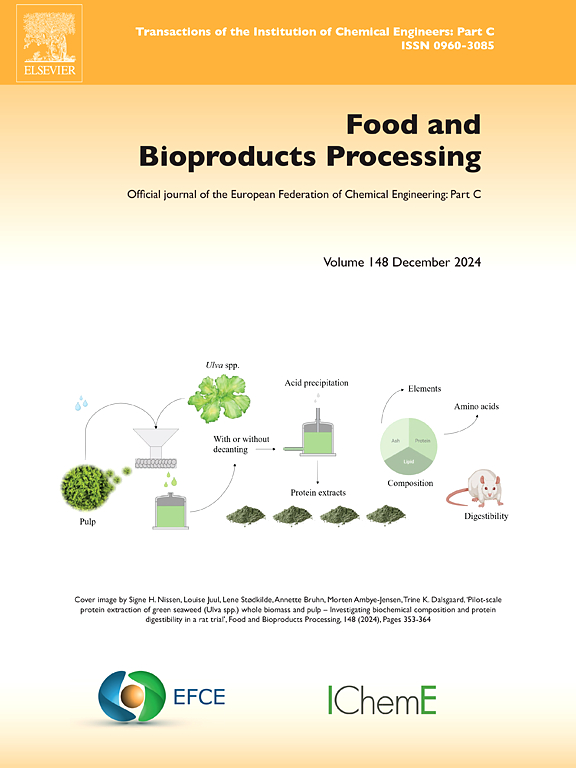脱乙酰葡萄糖甘露聚糖羧甲基化在水乳液中稳定油的性能
IF 3.4
2区 农林科学
Q2 BIOTECHNOLOGY & APPLIED MICROBIOLOGY
引用次数: 0
摘要
葡甘露聚糖是一种高粘性多糖,具有很强的油稳定和包封潜力。本研究旨在通过脱乙酰化和羧甲基化连续改性,提高葡甘露聚糖的亲脂性和乳化性能。然后用羧甲基化葡甘露聚糖(C-GM)稳定不同浓度的鱼油乳剂。结果表明,通过增加Na-MCA含量和延长反应时间对葡甘露聚糖进行改性,可显著提高其取代度,取代度可达0.085。取代的增加导致聚合物的分子量和亲脂性显著改善。羧基甲基化后的亲脂基团的成功附着不仅提高了对油的亲和性,而且降低了葡甘露聚糖的溶解度、吸水性、粘度、表面张力和临界胶束浓度(CMC),表明其向疏水行为的转变。此外,改性后的葡甘露聚糖的热稳定性得到了改善,这可以通过延迟热降解来证明。在功能上,C-GM表现出优异的乳化性能,在冷藏10天后,乳化活性高达97% %,相分离率仅为2% %,有效地保持了乳液的稳定性。这些增强突出了C-GM作为油基配方的高性能天然乳化剂的潜力。本文章由计算机程序翻译,如有差异,请以英文原文为准。
Performance of carboxymethylation of deacetylated glucomannan in stabilizing oil in water emulsion
Glucomannan, a high viscous polysaccharide, shows strong potential for oil stabilization and encapsulation. This study aims to enhance the lipophilic properties and emulsifying performance of glucomannan through a consecutive modification process involving deacetylation and carboxymethylation. The carboxymethylated glucomannan (C-GM) was then used to stabilize fish oil emulsion at different concentrations. The results show that modifying glucomannan through increased Na-MCA content and prolonged reaction duration significantly enhanced its degree of substitution, reaching up to 0.085. This increase in substitution led to notable improvements in the molecular weight and lipophilic characteristics of the polymer. The successful attachment of lipophilic groups following carboxymethylation not only improved oil affinity but also reduced the solubility, water absorption, viscosity, surface tension, and critical micelle concentration (CMC) of glucomannan, indicating a shift toward more hydrophobic behavior. Moreover, the thermal stability of the modified glucomannan was improved, as evidenced by a delayed onset of thermal degradation. Functionally, the C-GM demonstrated excellent emulsifying properties, achieving up to 97 % emulsifying activity and effectively maintaining emulsion stability with only 2 % phase separation after 10 days of cold storage. These enhancements highlight the potential of C-GM as a high-performance natural emulsifier for oil-based formulations.
求助全文
通过发布文献求助,成功后即可免费获取论文全文。
去求助
来源期刊

Food and Bioproducts Processing
工程技术-工程:化工
CiteScore
9.70
自引率
4.30%
发文量
115
审稿时长
24 days
期刊介绍:
Official Journal of the European Federation of Chemical Engineering:
Part C
FBP aims to be the principal international journal for publication of high quality, original papers in the branches of engineering and science dedicated to the safe processing of biological products. It is the only journal to exploit the synergy between biotechnology, bioprocessing and food engineering.
Papers showing how research results can be used in engineering design, and accounts of experimental or theoretical research work bringing new perspectives to established principles, highlighting unsolved problems or indicating directions for future research, are particularly welcome. Contributions that deal with new developments in equipment or processes and that can be given quantitative expression are encouraged. The journal is especially interested in papers that extend the boundaries of food and bioproducts processing.
The journal has a strong emphasis on the interface between engineering and food or bioproducts. Papers that are not likely to be published are those:
• Primarily concerned with food formulation
• That use experimental design techniques to obtain response surfaces but gain little insight from them
• That are empirical and ignore established mechanistic models, e.g., empirical drying curves
• That are primarily concerned about sensory evaluation and colour
• Concern the extraction, encapsulation and/or antioxidant activity of a specific biological material without providing insight that could be applied to a similar but different material,
• Containing only chemical analyses of biological materials.
 求助内容:
求助内容: 应助结果提醒方式:
应助结果提醒方式:


